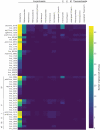Comprehensive glycoproteomics shines new light on the complexity and extent of glycosylation in archaea
- PMID: 34138841
- PMCID: PMC8241124
- DOI: 10.1371/journal.pbio.3001277
Comprehensive glycoproteomics shines new light on the complexity and extent of glycosylation in archaea
Abstract
Glycosylation is one of the most complex posttranslational protein modifications. Its importance has been established not only for eukaryotes but also for a variety of prokaryotic cellular processes, such as biofilm formation, motility, and mating. However, comprehensive glycoproteomic analyses are largely missing in prokaryotes. Here, we extend the phenotypic characterization of N-glycosylation pathway mutants in Haloferax volcanii and provide a detailed glycoproteome for this model archaeon through the mass spectrometric analysis of intact glycopeptides. Using in-depth glycoproteomic datasets generated for the wild-type (WT) and mutant strains as well as a reanalysis of datasets within the Archaeal Proteome Project (ArcPP), we identify the largest archaeal glycoproteome described so far. We further show that different N-glycosylation pathways can modify the same glycosites under the same culture conditions. The extent and complexity of the Hfx. volcanii N-glycoproteome revealed here provide new insights into the roles of N-glycosylation in archaeal cell biology.
Conflict of interest statement
The authors have declared that no competing interests exist.
Figures





Similar articles
-
The Archaeal Proteome Project advances knowledge about archaeal cell biology through comprehensive proteomics.Nat Commun. 2020 Jun 19;11(1):3145. doi: 10.1038/s41467-020-16784-7. Nat Commun. 2020. PMID: 32561711 Free PMC article.
-
AglQ is a novel component of the Haloferax volcanii N-glycosylation pathway.PLoS One. 2013 Nov 13;8(11):e81782. doi: 10.1371/journal.pone.0081782. eCollection 2013. PLoS One. 2013. PMID: 24236216 Free PMC article.
-
N-glycosylation in Archaea: on the coordinated actions of Haloferax volcanii AglF and AglM.Mol Microbiol. 2010 Feb;75(4):1047-58. doi: 10.1111/j.1365-2958.2009.07045.x. Mol Microbiol. 2010. PMID: 20487296
-
Add salt, add sugar: N-glycosylation in Haloferax volcanii.Biochem Soc Trans. 2013 Feb 1;41(1):432-5. doi: 10.1042/BST20120142. Biochem Soc Trans. 2013. PMID: 23356324 Review.
-
Not just for Eukarya anymore: protein glycosylation in Bacteria and Archaea.Curr Opin Struct Biol. 2008 Oct;18(5):544-50. doi: 10.1016/j.sbi.2008.06.010. Epub 2008 Aug 26. Curr Opin Struct Biol. 2008. PMID: 18694827 Review.
Cited by
-
N-glycosylation in Archaea - Expanding the process, components and roles of a universal post-translational modification.BBA Adv. 2024 Aug 29;6:100120. doi: 10.1016/j.bbadva.2024.100120. eCollection 2024. BBA Adv. 2024. PMID: 39296579 Free PMC article.
-
Proteolysis at the Archaeal Membrane: Advances on the Biological Function and Natural Targets of Membrane-Localized Proteases in Haloferax volcanii.Front Microbiol. 2022 Jun 24;13:940865. doi: 10.3389/fmicb.2022.940865. eCollection 2022. Front Microbiol. 2022. PMID: 35814708 Free PMC article. Review.
-
Functional Insights of Salinity Stress-Related Pathways in Metagenome-Resolved Methanothrix Genomes.Appl Environ Microbiol. 2022 May 24;88(10):e0244921. doi: 10.1128/aem.02449-21. Epub 2022 Apr 28. Appl Environ Microbiol. 2022. PMID: 35477253 Free PMC article.
-
Quorum sensing mediates morphology and motility transitions in the model archaeon Haloferax volcanii.bioRxiv [Preprint]. 2025 Jan 14:2025.01.14.633064. doi: 10.1101/2025.01.14.633064. bioRxiv. 2025. Update in: mBio. 2025 Jul 9;16(7):e0090625. doi: 10.1128/mbio.00906-25. PMID: 39868331 Free PMC article. Updated. Preprint.
-
Advancing archaeal research through FAIR resource and data sharing, and inclusive community building.Commun Biol. 2025 Mar 29;8(1):519. doi: 10.1038/s42003-025-07962-8. Commun Biol. 2025. PMID: 40157984 Free PMC article. Review.
References
-
- Mescher MF, Strominger JL. Purification and characterization of a prokaryotic glycoprotein from the cell envelope of Halobacterium salinarium. J Biol Chem. 1976;251:2005–2014. - PubMed
Publication types
MeSH terms
Substances
Grants and funding
LinkOut - more resources
Full Text Sources
Molecular Biology Databases

